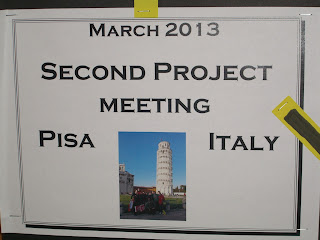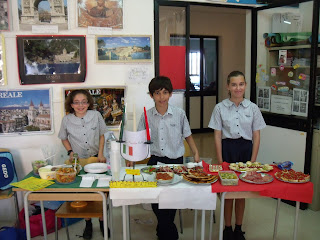Friday 28 June 2013
Traditional Maltese Games
During lessons of
Maltese, students looked back and saw how their parents and grand-parents used
to play. Especially with so many technological equipment in their hands, very
often the younger generation fails to realise that the most simple of games can
be fun too. Hereunder, some students present to you a few traditional Maltese
games. They wrote in Maltese and therefore it might be interesting for you to
see the written Maltese language. The photos and English captions will
help you understand how they were played.
Il-Borża
"Il-Ħamis it-2
ta’ Mejju morna ħarġa ġor-Rabat. Meta konna hemm morna ir-‘’Roman
Domus’’, l-katakombi ta’ San Pawl u l-ġnien publikku ħdejn id-dħul ta’
l-Imdina fejn lagħbna logħob antik Malti. Il-logħba li kont ħadt mieghi
jien hi l-borża. Il-logħba ‘BORŻA’ kienet tintlagħb l-aktar
fiż-żmien San
Martin u L-Millied għax f’dak iż-żmien kienu jimpurtaw il-qastan ,
ġelewż u l-lewż. Xi ħadd kien jkollu borża taċ-ċarruta li kien ikun fiha
il-lewż jew xi ħaġa oħra u jorbot il-borża ma’ biċċa ħabel irqiqa. It-tfal
kienu joqogħdu dawra tond madwar it-tifel jew it-tifla li se jdawwar
il-borża mimlija
bil-lewż. Dak li qed idawwar il-borża għandu jżomm il-borża fil-baxx ħalli ma
tkunx daqshekk diffiċli għal dawk li għandhom jaqbżu. Ma’ min taħbat joħrog
mill-logħba u jirbaħ l-aħħar wieħed li għadu qed jaqbeż." by Nicholas
Pullicino
Wednesday 26 June 2013
Prehistoric Malta...amazing!
Grade 9 outing
to the
Hagar Qim & Mnajdra Archaeological Park and to the Tarxien Temples
Monday the 20th of May
2013 was a special day for the Grade 9 students of San Andrea School since they
spent the day visiting some of Malta’s megalithic temples to complement what
they had already learnt in class about Maltese prehistory.
We started the day by visiting
the Visiting Centre at the Hagar Qim and Mnajdra Archaeological Park. At this visitor centre, the students had the
opportunity to learn from the various interactive displays available. The students then proceeded to visit the
megalithic temples of Hagar Qim and Mnajdra where they viewed all the various
unique features of these UNESCO World Heritage Sites.
In the afternoon, the students
visited another world heritage site, the megalithic temples of Tarxien. During their guided tour of this site, the
students learnt, amongst other things, about how the site was discovered, who
excavated it and the various unique decorative elements of the temple.
This outing was truly enjoyable
for the students since it was very informative and fun at the same time.
Monday 17 June 2013
A Special Invitation from our young students of Italian
During a special Italian lesson, dedicated to typical Italian food, beverages and dishes, the four classes of Grade 8 were divided in 5 teams. Each team had to bring Italian food and drinks from home and prepare a restaurant-like display in class. Every group gave a name for their restaurant and at the end of the activity, all the food was shared.
The different groups voted for the best display. This project was a huge success, so much so that it was appreciated also by members of staff who visited the classroom and joined in the food-tasting activity. Well done Mr. Mark and students!
The different groups voted for the best display. This project was a huge success, so much so that it was appreciated also by members of staff who visited the classroom and joined in the food-tasting activity. Well done Mr. Mark and students!
A journey in time: a visit to St. Paul's Catacombs and the Roman Domus
· The teacher of History, Ms Maria Zammit, organised an educational outing for her students. Hereunder are the Students reviews about this outing.
St. Paul’s Catacombs
We had a school outing to the catacombs. They were used to bury people underground in sections dug in
walls. These catacombs were once located just outside the walls of the ancient
city of Mdina. When you enter the catacombs you immediately see 2 agape tables,
which were used to do a feast celebrating that the dead person went to heaven.
There are 3 types of catacombs in this complex.
As we continued going in, we saw more tombs which were of
higher standards. Most of the tombs we saw were the Canopy tombs which had a
space for an adult and a space for a 2-3 year old child on top of the adult. While
we were walking out, some people couldn’t help not scaring someone else! To me this
was one of the best outings I ever had as a student at San Andrea.
Matthias Bartolo 8.2
St. Paul’s Catacombs were built around the 3rd and 4th century A.D. When we went to the catacombs, we were so overjoyed and some were
scared as there were ants and it was very dark inside. Our tour guide was very
friendly and answered all questions including some crazy ones. We learnt that
people used to be buried there and they used to use a nail and chisel to dig the
holes perfectly for the people and they made pillows out of rock, so they would
have a fantastic afterlife. We learnt that there were more than 2000 slots and that people at that time used to meet there. What we saw was amazing especially the place where they buried
doctors, surgeons and more, along with their tools made out of clay. I must say
that this was an experience that I will never forget even though some students gave
frights to everyone and scaring them and me. It was an awesome day and that day
did not end as we also went to the Roman Villa.
Emily Abela 8.2
The St. Paul's Catacombs, located in Rabat, was a burial place for the dead that can be entered through four entrances. The Romans respected the dead and when a person died they used to leave meals for the dead, which was an ancient roman custom. This fascinating labyrinth of the 3rd century AD is dedicated to St. Paul because of the church built above it. The style of these catacombs is Paleochristian where we can find 5 types of tombs such as the Lucullus, Canope and the Saddle back. When these structures were built, no space was wasted and the tombs were either double or single. There were also tombs for children because most children at that time used to die before the age of 5. During the persecution of Christians in the Roman Empire, the Christians that lived in Malta used to pray in secret in the catacombs and gathered around a table called agape. These are a good example of the catacombs that are found around the Mediterranean and are a must see for the historic enthusiast.
Katrina Deidun 8.4
The Roman Domus
On Thursday 2nd May we went to the Roman Domus. We saw many interesting things such as ancient roman coins, statues of emperors and much more. We saw Islamic tombstones and mosaics which are tiles glued on rocks or the floor to make a picture. This Villa was transformed into a museum. It is the only substantial building found in the city. It is also the richest example of Roman house found in Malta. The statues and mosaics are the finest found in the Mediterranean. This Domus served also as a business place were most business was conducted. It was built in the middle of the 1st century BC. This fascinating museum was open to the public in February 1882 more than 131 years ago. It consists of pottery used in the roman era. It was mainly used in the republican and early imperial periods. On this little island there is a lot to learn about roman times.
Krista Spiteri Lucas 8.4
·
Monday 3 June 2013
Students from Ks. Kwiatkowski School in Bychawa on a trip to the Open Air Village Museum in Lublin
Last week students from the 1st grade of the Lower Secondary School (Gimnazjum), aged 13, visited the Open Air Village Museum in Lublin. It's a place where everyone can see how life looked like in the Polish countryside in the 18th and 19th century. Some of the exhibits, like old churches and chapels, date back to 17th century.
Our students could learn more about works done by villagers at that time:
- farming land, growing crops and harvesting, raising animals,
- baking bread and crude biscuits,
- weaving
- pottery
- basketry
- blacksmithing
They heard interesting stories about daily life and farmwork of Polish peasants, about their traditions and ritual events. They could see displays of disappearing crafts, thatched cottages, a manor house and the exhibition featuring life of a middle class landed proprietor, an old firehouse with the equipment of the District Fire Brigade from Bedlno in 1936, a 17th century church from the village Matczyn, a presbytery, a granary and traditional windmills.
Our students were really impressed with what they saw:
"The old houses are great, they are so simple and at the same time so naturally beautiful. I really liked the animals too: cows and goats on the pastures, they were cute." (Aneta)
"The most interesting things for me were the animals, the goats and the horse by the windmill. I also liked the smithy where the blacksmith made a horseshoe for us." (Anna)
"What I liked most was the interior of an old cottage, the ornaments, the basic furniture like beds and tables. I was really surprised that even six people could sleep in one room. It must have been very uncomfortable." (Piotr)
"The old architecture and buildings are so interesting. They could make everything using wood only. They didn't need any iron nails. This is so amazing." (Patryk)
"Life in the past wasn't easy and comfortable, they all had to work really hard, even the kids helped their parents on the farm. But they were able to spend a lot of time together. This is really good." (Ilona)
Our students could learn more about works done by villagers at that time:
- farming land, growing crops and harvesting, raising animals,
- baking bread and crude biscuits,
- weaving
- pottery
- basketry
- blacksmithing
They heard interesting stories about daily life and farmwork of Polish peasants, about their traditions and ritual events. They could see displays of disappearing crafts, thatched cottages, a manor house and the exhibition featuring life of a middle class landed proprietor, an old firehouse with the equipment of the District Fire Brigade from Bedlno in 1936, a 17th century church from the village Matczyn, a presbytery, a granary and traditional windmills.
Our students were really impressed with what they saw:
"The old houses are great, they are so simple and at the same time so naturally beautiful. I really liked the animals too: cows and goats on the pastures, they were cute." (Aneta)
"The most interesting things for me were the animals, the goats and the horse by the windmill. I also liked the smithy where the blacksmith made a horseshoe for us." (Anna)
"What I liked most was the interior of an old cottage, the ornaments, the basic furniture like beds and tables. I was really surprised that even six people could sleep in one room. It must have been very uncomfortable." (Piotr)
"The old architecture and buildings are so interesting. They could make everything using wood only. They didn't need any iron nails. This is so amazing." (Patryk)
"Life in the past wasn't easy and comfortable, they all had to work really hard, even the kids helped their parents on the farm. But they were able to spend a lot of time together. This is really good." (Ilona)
 |
| A traditional farmyard |
 |
| Inside a cottage |
 |
| A weaving loom and other traditional machines used by 19th century farmers |
 |
| The blacksmith at work |
Subscribe to:
Posts (Atom)








































































